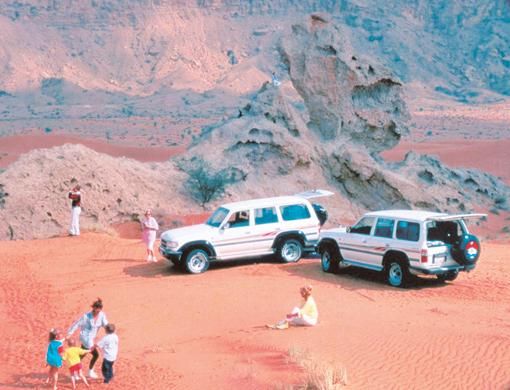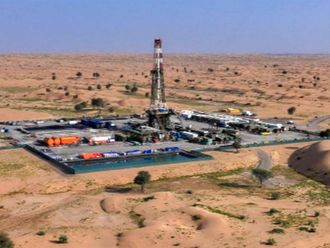Despite that the Middle East region prides itself of its spectacular combination of ancient civilisations, rich history, evolving culture and diverse nature, it has not grabbed, so far, a prominent share of the global tourism economy.
Click here to see 'The Travel & Tourism Competitiveness Index 2007'
Click here to see 'Selected Travel & Tourism indicators for Arab world countries'
However, experts expect the current average annual increase in tourist arrivals to the region to continue, and to record the highest worldwide growth rates by 2020. They add there is a need to seize available opportunities to present the unique characteristics of the region to the rest of the world, and to draw new plans of "new tastes and new styles" of tourism.
With a 9.5 per cent average annual increase in tourist arrivals between 2000 and 2004, the Middle East region has already recorded the fastest growth of any region and comparable with worldwide travel and tourism (T&T) of 2.7 per cent during the same period, international tourism figures show.
"The Middle East and Africa are forecast to record growth at rates of more than five per cent year, compared to the world average of 4.1 per cent," said the World Tourism Organisation (UNTWO) in its 2020 vision forecasts. Europe, East Asia and the Pacific and the Americas are going to be the top three receiving regions in the next few years.
They are expected to be followed by Africa, the Middle East and South Asia, according to UNTWO. Mohammad Dahmash, Dubai-based regional partner leading the real estate advisory group in the Middle East, said "certain factors" are contributing to tourism growth in the Middle East, which is also benefiting other sectors of economy.
"Hospitality infrastructure development, robust airline connectivity, active world-wide marketing, government commitment, sun and sand, and tourist- oriented leisure and entertainment facilities ... [Meanwhile] other sectors that are gaining prominence are financial services, telecommunication, real estate and construction and infrastructure," he said.
The Middle East is the cradle of ancient civilisations and the birthplace of world's monotheist religions. The region's precious collections of archeological monuments and ruins, including wonders of ancient and modern times: Egypt's pyramids, Iraq's hanging gardens of Babylon (which today exists through a duplicate), lighthouse of Alexandria, and recently Jordan's Petra.
Furthermore, the region has a long list of diverse nature to offer today - ranging from green mountains in Lebanon and pristine beaches of North African and Middle Eastern countries overlooking the Arabian Gulf and the Mediterranean Sea, to rare colourful rock formations, as in Wadi Rum and Petra in southern Jordan, and the charming colourful underwater coral reefs in the Red sea.
The diversity of the region calls for a diverse "forms of tourism, new tastes and new styles of travel", say experts, especially that there are big potential for the sector, as shown by international figures. According to a paper presented to the World Economic Forum last year, the Middle East's 9.6 million arrivals in 1990, accounted for just 2.2 per cent of international tourist arrivals. In the same year, tourist arrivals in all of Africa, including North Africa, were just 15.2 million.
"Today, travel and tourism in the Arab world still accounts for only six per cent of international tourist arrivals showing the growth opportunities that remain for the sector," according to the 2007 paper.
Apart from actively promoting tourism on a world-wide platform, following the footsteps of some Gulf countries, and formulating a more cohesive tourism strategies, "cultural uniqueness of the region needs to be better communicated to the world," said Dahmash. "There is an opportunity to create awareness of the wide-range of tourism options available in the region."
Dahmash strongly believe one of the avenues that can explored in tourism in Middle East is "heritage and cultural tourism," where the world's heritage sites are highlighted, as well as other sports activities, such as diving, golf, motor racing and equestrian events.
Johns Hopkins University's Walid Hazbun, who wrote several papers on tourism in the Arab world, believe some of the new tastes of travel might include everything from religion-oriented travel to ecotourism and adventure travel in which Arab travellers make up only a limited share. He said there are new tastes of leisure tourism created by marketers and entrepreneurs, while governments can help on both sides of the supply and demand. Governments, he said, can also coordinate with companies on the regional level to promote tourism from inside and outside the Arab region.
Regional networks and chains could also expand the benefits of Arab tourism. "More generally I think alternative tourism development models could promote tourist experiences based on Islamic heritage, Arab history, and contemporary urban culture," said Hazbun. "Drawing on models of urban tourism in European historic cities, Arab cities could seek to expose visitors to the contemporary culture of Arab cities and Islamic historical cultural references by building tourist zones with attractions such as art and contemporary history museums, vernacular architecture, music concerts, and films," he added.
Many researchers and experts join Hazbun in saying promoting "national" tourism is an effective way to formulate a national identity, and a way of national integration, as was the case in Europe and the US. "I have seen little of this in the Arab world [outside schoolchildren being sent to national historical sites]. Many tourists sites remain too commercial [shopping malls, amusement parks] while others, such as archaeological ruins, have tended to mostly appeal to western tourists," noted the Arab-American professor. "While Arab governments might not want to replicate the patterns of Western states, they might consider cultural heritage policies that find new ways to promote middle class leisure in ways that also help forge national identity and citizenship... while at the same time challenging more leisure spending domestically," Hazbun said. "Within the Arab region there are possibilities for regional programmes," he added.
Social fabrics
By the same token, there is a need to preserve the social fabrics of the Arab societies, which vary in conservative degrees, from any negative impact of mixing with other cultures. In GCC countries, officials downplayed any negative concerns. "Interaction with other cultures is something that GCC nationals have done for hundreds of years, perhaps thousands of years if you want to go that far," Dr Abdul Aziz Abu Hamad Aluwaisheg, Minister Plenipotentiary and Director of the Economic Integration Department, Economic Affairs of the Gulf Cooperation Council (GCC), told Gulf News from Riyadh.
"Obviously, authorities have to be vigilant to guard against swindlers and other criminals, but that goes without saying. Investment in law and order is essential for successful tourism," he said. The UAE was the top performer in the Arab region in the fields of safety of security and infrastructure, according to international parameters. Finland and Austria, respectively, came on the top of the global list.
While experts believe governments should consider ways to promote new forms of tourism experiences that "are not isolated behind walls", and allow visitors to "experience and appreciate" differences and similarities between their origin countries and the visiting ones, "Local communities, they added, need to be empowered to have influence over tourism development to prevent unwanted forms of tourism development from being imposed on them.
Furthermore, while tourism offer prospects of providing much-needed employment opportunities and foreign currency to the Arab economies, experts say plans to overcome distorting tourism elements to economies and labour markets should be in place. "Too often the sector seems to promise economic opportunities and lead young people to work in the sector only to find its benefits are unstable and skill development and promotion limited. Higher standards for tourism experiences should be coupled with higher levels of human capital and the creation of skilled work in the sector," Hazbun said.
Experts also have another set of concerns related to environment and resources used. Meanwhile new tourism plans needed for the region, Hazbun wrote in one of his papers, should include several elements. They include "mitigate any negative cultural aspect, enhance the positive, get beyond the enclave, promote cultural heritage, encourage regional tourism flows and ending the Arab-Israeli conflict." Tourism in the Middle East seems prone to conflicts and political developments.
But the sector became stronger when it rebounded after 9/11 attacks, when there were predictions that it will collapse. But this didn't happen. After the attacks and the following war in Afghanistan and the series of attacks against tourist locations in Bali, Tunisia, and Morocco, international tourism to the Middle East suffered major shocks, especially that Palestine was witnessing an ongoing Intifada and the US led a war on Iraq in March 2003.
The Middle East came out of these obstacles as one of the few winders, and experts say the revival of Middle East tourism did not come from increasing numbers of American, European, and Japanese visitors and investors but mainly from regional Middle East sources, where Arabs avoided travelling to Europe and the US preferring other Arab destinations.
Their flows, believe Hazbun, have sustained the "Egyptian tourism economy, led to the rebirth of Beirut as regional cultural capital, and put Dubai on the world tourism map as one of the fast growing destinations in a region rapidly promoting tourism as a new engine of economic growth and vehicle for globalisation and transnational integration".
- This is the first part of a special coverage on regional tourism. GCC tourism trends and potential runs tomorrow.












